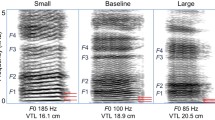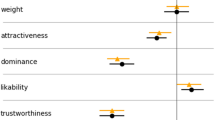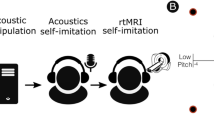Abstract
Evidence suggests that people can manipulate their vocal intonations to convey a host of emotional, trait, and situational images. We asked 40 participants (20 men and 20 women) to intentionally manipulate the sound of their voices in order to portray four traits: attractiveness, confidence, dominance, and intelligence to compare these samples to their normal speech. We then asked independent raters of the same- and opposite-sex to assess the degree to which each voice sample projected the given trait. Women’s manipulated voices were judged as sounding more attractive than their normal voices, but this was not the case for men. In contrast, men’s manipulated voices were rated by women as sounding more confident than their normal speech, but this did not hold true for women’s voices. Further, women were able to manipulate their voices to sound just as dominant as the men’s manipulated voices, and both sexes were able to modify their voices to sound more intelligent than their normal voice. We also assessed all voice samples objectively using spectrogram analyses and several vocal patterns emerged for each trait; among them we found that when trying to sound sexy/attractive, both sexes slowed their speech and women lowered their pitch and had greater vocal hoarseness. Both sexes raised their pitch and spoke louder to sound dominant and women had less vocal hoarseness. These findings are discussed using an evolutionary perspective and implicate voice modification as an important, deliberate aspect of communication, especially in the realm of mate selection and competition.


Similar content being viewed by others
References
Amir, O., & Biron-Shental, T. (2004). The impact of hormonal fluctuations on female vocal folds. Current Otolaryngological Head and Neck Surgery, 12, 180–184.
Anolli, L., & Ciceri, R. (2002). Analysis of the vocal profiles of male seduction: From exhibition to self-disclosure. Journal of General Psychology, 129, 149–169.
Apicella, C. L., Feinberg, D. R., & Marlowe, F. W. (2007). Voice pitch predicts reproductive success in male hunter-gatherers. Biology Letters, 3, 682–684.
Apple, W., Streeter, L. A., & Krauss, R. M. (1979). Effects of pitch and speech rate on personal attributions. Journal of Personality and Social Psychology, 37(5), 715–727.
Borkowska, B., & Pawlowski, B. (2011). Female voice frequency in the context of dominance and attractiveness perception. Animal Behaviour, 82, 55–59.
Brody, L., & Hall, J. A. (1993). Gender and emotion. In M. Lewis & J. Haviland (Eds.), Handbook of emotions (pp. 447–460). New York: Guilford.
Brown, B. L., Strong, W. J., & Rencher, A. C. (1973). Perceptions of personality from acoustic speech: Effects of manipulations of acoustical parameters. The Journal of the Acoustical Society of America, 54(1), 29–35.
Brown, B. L., Strong, W. J., & Rencher, A. C. (1974). Fifty-four voices from two: The effects of simultaneous manipulations of rate, mean fundamental frequency, and variance of fundamental frequency on ratings of personality from speech. The Journal of the Acoustical Society of America, 55(2), 313–318.
Burnham, D., Kitamura, C., & Vollmer-Conna, U. (2002). What’s new, pussycat? Talking to babies and animals. Science, 296(5572), 1435.
Buss, D. M. (1988). The evolution of human intra sexual competition: Tactics of mate attraction. Journal of Personality and Social Psychology, 54, 616–628.
Buss, D. M. (1989). Sex differences in human mate preferences: Evolutionary hypotheses tested in 37 cultures. Behavior and Brain Sciences, 12, 1–14.
Buss, D. M. (1990). Derogation of competitors. Journal of Social and Personal Relationships, 7, 395–422.
Buss, D. M., & Schmitt, D. P. (1993). Sexual strategies theory: An evolutionary perspective on human mating. Psychological Review, 100, 204–232.
Buss, D. M., Shackelford, T. K., Kirkpatrick, L. A., & Larsen, R. L. (2001). A half century of mate preferences: The cultural evolution of values. Journal of Marriage and Family, 63, 491–503.
Chang, R. S., and Garcia, J. R. (2011). Behind closed doors: On the use of loverese and pet-names between romantic partners. Poster session presented at the Annual Conferences of the Northeast Evolutionary Society, Binghamton, NY.
Cohen, J. (1988). Statistical power analysis for the behavioral sciences (2nd ed.). Hillsdale: Erlbaum.
Cooper, R. P., & Aslin, R. N. (1994). Developmental differences in infant attention to the spectral properties of infant-directed speech. Child Development, 65, 1663–1677.
Dabbs, J. M., & Mallinger, A. (1999). High testosterone levels predict low voice pitch among men. Personality and Individual Differences, 27, 801–804.
Dijkstra, P., & Buunk, B. P. (2001). Sex differences in the jealousy-evoking nature of a rival’s body build. Evolution and Human Behavior, 22(5), 335–341.
Ekman, P., Friesen, W. V., & Scherer, K. (1976). Body movements and voice pitch in deceptive interaction. Semiotica, 16, 23–27.
Evans, S., Neave, N., & Wakelin, D. (2006). Relationships between vocal characteristics and body size and shape in human males: An evolutionary explanation for a deep male voice. Biological Psychology, 72, 160–163.
Farley, S. D., Hughes, S. M., & LaFayette, J. N. (2013). People will know we are in love: Evidence of differences between vocal samples directed toward lovers and friends. Journal of Nonverbal Behavior, 37(3), 123–138. doi:10.1007/s10919-013-0151-3.
Feinberg, D. R., DeBruine, L. M., Jones, B. C., & Perrett, D. I. (2008). The role of femininity and averageness of voice pitch in aesthetic judgments of women’s voices. Perception, 37, 615–623.
Feinberg, D. R., Jones, B. C., Little, A. C., & Perrett, D. I. (2005). Manipulations of fundamental and formant frequencies influence the attractiveness of human male voices. Animal Behaviour, 69, 561–568.
Fernald, A. (1985). Four-month-old infants prefer to listen to motherese. Infant Behavior and Development, 8, 181–195.
Fernald, A., & Kuhl, P. (1987). Acoustic determinants of infant preference for motherese speech. Infant Behavior and Development, 10(3), 279–293.
Fisher, M., Cox, A., & Gordon, F. (2009). Self-promotion versus competitor derogation: The influence of sex and romantic relationship status on intra sexual competition strategy selection. Journal of Evolutionary Psychology, 7(4), 287–308.
Fitch, W. T., & Hauser, M. D. (1995). Vocal production in nonhuman primates: Acoustic, physiology, and functional constraints on ‘honest’ advertisement. American Journal of Primatology, 37, 191–219.
Floyd, K., & Ray, G. B. (2003). Human affection exchange: IV: Vocalic predictors of perceived affection in initial interactions. Western Journal of Communication, 67(1), 56–73.
Gangestad, S. W., & Thornhill, R. (2003). Facial masculinity and fluctuating asymmetry. Evolution and Human Behavior, 24, 231–241.
Hall, J. A. (1978). Gender effects in decoding nonverbal cues. Psychological Bulletin, 85(4), 845–857.
Hall, J. A., & Braunwald, K. G. (1981). Gender cues in conversations. Journal of Personality and Social Psychology, 40, 99–110.
Hughes, S. M., Dispenza, F., & Gallup Jr, G. G. (2004). Ratings of voice attractiveness predict sexual behavior and body configuration. Evolution and Human Behavior, 25, 295–304.
Hughes, S. M., Farley, S. D., & Rhodes, B. C. (2010). Vocal and physiological changes in response to the physical attractiveness of conversational partners. Journal of Nonverbal Behavior, 34, 155–167.
Hughes, S. M., Harrison, M. A., & Gallup Jr, G. G. (2002). The sound of symmetry: Voice as a marker of developmental instability. Evolution and Human Behavior, 23, 173–180.
Hughes, S. M., Pastizzo, M. J., & Gallup Jr, G. G. (2008). The sound of symmetry revisited: Subjective and objective analyses of voice. Journal of Nonverbal Behavior, 33, 93–108.
Hughes, S., & Rhodes, B. C. (2010). Making age assessments based on voice: The impact of the reproductive viability of the speaker. Journal of Social, Evolutionary and Cultural Psychology, 4(4), 290–304.
Ickes, W., Gesn, P. R., & Graham, T. (2000). Gender differences in empathic accuracy: Differential ability or differential motivation? Personal Relationships, 7, 95–109.
Jansz, J. (2000). Masculine identity and restrictive emotionality. In A. H. Fischer (Ed.), Gender and emotion: Social psychological perspectives (pp. 166–186). Cambridge: Cambridge University Press.
Jiang, J., Lin, E., Wang, J., & Hanson, D. G. (1999). Glottographic measures before and after levodopa treatment in Parkinson’s disease. Laryngoscope, 109, 1287–1293.
Jones, B. C., Little, A. C., Penton-Voak, I. S., Tiddeman, B. P., Burt, D. M., & Perrett, D. I. (2001). Facial symmetry and judgments of apparent health: Support for a “good genes” explanation of the attractiveness-symmetry relationship. Evolution and Human Behavior, 22, 417–429.
Karpf, A. (2006). The human voice. New York: Bloombury.
Kimble, C. E., & Seidel, S. D. (1991). Vocal signs of confidence. Journal of Nonverbal Behavior, 15, 99–105.
Kitamura, C., Thanavisuth, C., Burnham, D., & Luksaneeyanawin, S. (2002). Universal pitch modifications in infant directed speech: A prelinguistic longitudinal study in a tonal and non-tonal language. Infant Behavior and Development, 24(4), 372–392.
Klofstad, C. A., Anderson, R. C., & Peters, S. (2012). Sound like a winner: Voice pitch influences perception of leadership capacity in both men and women. Proceedings of the Royal Society, 279(1738), 2698–2704.
Krauss, R. M., Freyberg, R., & Morsella, E. (2002). Inferring speakers’ physical attributes from their voices. Journal of Experimental Social Psychology, 38, 618–625.
Luxen, M. F., & Buunk, B. P. (2006). Human intelligence, fluctuating asymmetry and the peacock’s tail: General intelligence as an honest signal of fitness. Personality and Individual Differences, 41, 897–902.
Montepare, J. M., & Vega, C. (1988). Women’s vocal reactions to intimate and casual male friends. Personality and Social Psychology Bulletin, 14, 103–113.
O’Connor, J. J. M., & Feinberg, D. R. (2012). The influence of facial masculinity and voice pitch on jealousy and perceptions of intra sexual rivalry. Personality and Individual Differences, 52, 369–373.
Oguchi, T., & Kikuchi, H. (1997). Voice and interpersonal attraction. Japanese Psychological Research, 39, 56–61.
Pipitone, R. N., & Gallup, G. G., Jr. (2008). Women’s attractiveness varies across the menstrual cycle. Evolution and Human Behavior, 26, 268–274.
Prato-Previde, E., Fallani, G., & Valsecchi, P. (2006). Gender differences in owners interacting with pet dogs: An observational study. Ethology, 112(1), 64–73.
Prokosch, M. D., Coss, R. G., Scheib, J. E., & Blozis, S. A. (2009). Intelligence and mate choice: Intelligent men are always appealing. Evolution and Human Behavior, 30, 11–20.
Prokosch, M. D., Yeo, R. A., & Miller, G. F. (2005). Intelligence tests with higher g-loadings show higher correlations with body symmetry: Evidence for a general fitness factor mediated by developmental stability. Intelligence, 33, 203–213.
Puts, D. A., Gaulin, S., & Verdolini, K. (2006). Dominance and the evolution of sexual dimorphism in human voice pitch. Evolution and Human Behavior, 27, 283–296.
Puts, D. A., Hodges, C. R., Cardenas, R. A., & Gaulin, S. J. C. (2007). Men’s voices as dominance signals: Vocal fundamental and formant frequencies influence dominance attributions among men. Evolution and Human Behavior, 28, 340–344.
Roux, A., & Bergman, T. J. (2012). Indirect rival assessment in a social primate Theropithecus gelada. Animal Behaviour, 83(1), 249–255.
Rucas, S. L., Gurven, M., Kaplan, H., Winking, J., Gangestad, S., & Crespo, M. (2006). Female intra sexual competition and reputational effects on attractiveness among Tsimane of Bolivia. Evolution and Human Behavior, 27, 40–52.
Saxton, T. K., Burriss, R. P., Murray, A. K., Rowland, H. M., & Roberts, C. (2009). Face, body and speech cues independently predict judgments of attractiveness. Journal of Evolutionary Psychology, 7, 23–35.
Scherer, K. R. (1995). Expression of emotion in voice and music. Journal of Voice, 9(3), 235–248.
Schieb, J. E., Gangestad, S. W., & Thornhill, R. (1999). Facial attractiveness, symmetry and cues of good genes. Proceedings of the Royal Society B: Biological Sciences, 266, 1913.
Sell, A., Bryant, G. A., Cosmides, L., Tooby, J., Sznycer, D., von Rueden, C., et al. (2010). Adaptations in humans for assessing physical strength from the voice. Proceedings of the Royal Society B, 277, 3509–3518.
Shao, J., MacCallum, J. K., Zhang, Y., Sprecher, A., & Liang, J. J. (2010). Acoustic analysis of the tremulous voice: Assessing the utility of the correlation dimension and perturbation parameters. Journal of Communication Disorders, 43, 35–44.
Sprecher, S. (1989). The importance to males and females of physical attractiveness, earning potential and expressiveness in initial attraction. Sex Roles, 21, 591–607.
Steckler, N. A., & Rosenthal, R. (1985). Sex differences in nonverbal and verbal communication with bosses, peers, and subordinates. Journal of Applied Psychology, 70, 157–163.
Streeter, L. A., Krauss, R. M., Geller, V. J., Olson, C. T., & Apple, W. (1977). Pitch changes during attempted deception. Journal of Personality and Social Psychology, 35, 345–350.
Touhey, J. C. (1974). Effects of dominance and competence on heterosexual attraction. British Journal of Social and Clinical Psychology, 13, 22–26.
Tuomi, S. K., & Fisher, J. E. (1979). Characteristics of a simulated sexy voice. Folia Phoniatrica, 31, 242–249.
Tusing, K. J., & Dillard, J. P. (2000). The sounds of dominance: Vocal precursors of perceived dominance during interpersonal influence. Human Communication Research, 26, 148–171.
Acknowledgments
We wish to thank The Summer Albright College Research Experience Program (ACRE) for their support of this research.
Author information
Authors and Affiliations
Corresponding author
Rights and permissions
About this article
Cite this article
Hughes, S.M., Mogilski, J.K. & Harrison, M.A. The Perception and Parameters of Intentional Voice Manipulation. J Nonverbal Behav 38, 107–127 (2014). https://doi.org/10.1007/s10919-013-0163-z
Published:
Issue Date:
DOI: https://doi.org/10.1007/s10919-013-0163-z




